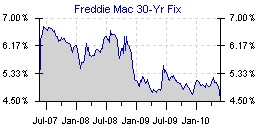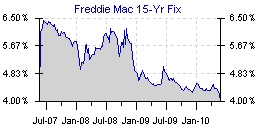I read THIS ARTICLE in the NY Times over the weekend in which a couple financial advisers explain how homeowner’s should evaluate whether or not it makes sense to refinance. Here is the summary directly from the article:
“…homeowners will need to determine their closing costs and monthly savings. Divide closing costs by savings; that tells you how many months it will take to break even. If you plan to stay put that long, a refinance might work.”
However, I take issue with this simplistic approach because it doesn’t take into account the character of the monthly savings. For example, if a homeowner is 10 years into a 30-year mortgage and decides to refinance into a new 30-year mortgage they will experience monthly payment savings just from the fact that they’d be stretching out their existing mortgage over 30 years instead of the remaining 20. Monthly cash-flow savings does not necessarily represent “savings” just like transferring money from your savings account into your checking account doesn’t represent “income”. If it did then everyone would have an interest-only mortgage.
Here’s an example, let’s assume a homeowner took a $300,000 30-year fixed rate mortgage out 10 years ago at 5.00%. Their monthly principal and interest payment is $1,610 and they have $246,484 remaining on the loan. Let’s assume that they call a local lender to inquire about a refinance and the lender offers them a new 30-year fixed rate mortgage at 4.75% in the amount of $246,500. Under this loan their new monthly payment would be $1,286 and the closing costs are $3,300.
If the homeowner plans on being in the home for the next 3 years and applies the aforementioned methodology then they would proceed with the refinance because they would calculate their “break-even” to be 10 months ($3,300 in closing costs divided by $325 per month in “savings”). However, this would not be a good decision because the “savings” is not coming from reduced interest but the re-amortization of the mortgage. In fact, during the first 10 months the homeowner would save only $459 in interest ($10,160 vs. $9,701).
This homeowner would actually be worse off after 3 years had they refinanced. Over the first 3 years of the loan they would have saved only $1,049 of interest even though their cash-flow savings was $11,700. You can see all the numbers HERE.
Grant it, I realize the numbers in this example are extreme. A homeowner who was 10 years into a 30-year fixed rate mortgage with a rate of 5.00% probably intuitively knows that refinancing into a 4.75% rate at a cost of $3,300 doesn’t make sense. However, I don’t think many financial professionals, personal finance writers, or even mortgage professionals understand the correct way to make these calculations. Unless you’re an excel wizard it’s best to make sure your mortgage professional knows and understand these concepts so they can help guide you into the right decision. When you inquire about refinancing be sure to ask them to make the correct calculations including total payments, projected interest, principal, and closing costs.


